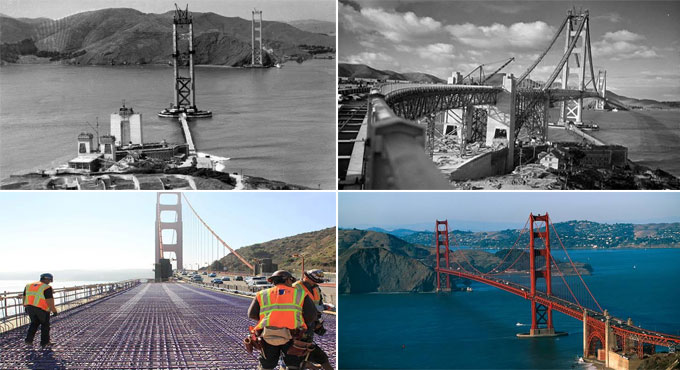
Golden Gate Bridge - A Feat of Construction Engineering
The Towers: As per the suspension-bridge idea, the weight of the roadway is slung from two towers at either end of the channel, each of which is 746 feet (227 meters) high. Until 1993, that held the record for being the world?s tallest bridge as well. The span itself clears 67 meters or 220 feet above the water. The two towers have a honeycomb lattice cellular design which makes them lightweight yet strong, like tree trunks. Between them, the towers required 1.2 million rivets to make this cellular design. Each tower consumed about 40000 metric tons of steel.
The Piers: The towers stand upon concrete piers on both sides. The north pier?s foundations extend 100 feet below the surface and 35 feet into bedrock. Even then, it was questioned whether the structure.
can withhold a major earthquake. However, it was relatively easier to build. But the south pier was a different story altogether. It connects to a shelf of bedrock 110 feet below the surface of the water, and the sea bed is sloped there. With the major difficulties, it took an extra year to build only this pier and foundation.
To build this, a huge oval-shaped concrete barrier or fender had to be constructed first around the location and then pump out the water out of this. When done, it earned the nickname of ?a bathtub for the South Tower.? Divers played a critical role in this.
The Cables: The roadway that is supported by triangular-frame truss hangs from vertical suspension ropes which deliver the load to two main cables from tower to tower. Each cable is 36.5 inches wide and is made of 27572 strands of galvanized steel wire each a pencil thick. The cables hang from saddles on top of the towers. Each cable alone weighs 12000 tons. Too heavy to carry up and slung in place, instead they were spun in place using a method called cable spinning. It involved securing one end of one pencil-thick steel wire at one side of the bridge, carry it over both saddles on both towers, securing it at the other anchorage and then sending it back the same way. This spinning marked a milestone of efficiency when it was finished in only six months.
The Span: The triangles in them easily mark out the trusses on each side of the roadway deck, which hold up the weight of the road, the cars on it, and other assorted buildings on top of the roadway. They also stiffen the bridge against the strong winds in this region. For a reference, the immensely powerful towers still sway 12 feet at the top due to the wind! The trusses span 50 feet between the suspender ropes. They may look delicate and thin from a distance, but they are 25 feet deep. They had to be built through a careful routine so as not to disturb the load-bearing harmony of the two suspender cables. The final paving for the roadway was finished just a month before the opening of the bridge in April 1937.
The Safety: Strauss was adamant on the point that the brave workers who have come forward to take up such a difficult challenge should not get harmed. It is to be noted that at that time heavy construction much more of a dangerous task than today; each million spent generally consumed a human life. However, Joseph Strauss meant to change all that.
The most well-known safety feature used by Strauss is the Safety Net. Slung beneath the bridge, it saved 19 lives, though it took $130000 to make. Additionally, Strauss made the workers wear special protective goggles to protect from glare, special cream to protect from the salty air. Also, the workers were told to consume only some certain dietary to reduce dizziness.
To be noted that eleven men still died in the Golden Gate Bridge project even after all the safeguards in two accidents.
The Finishing: At last, at 6 am on the 27th of May, 1937, the bridge was opened for pedestrian use. At least 18000 people were waiting to be the first ones to access the bridge despite a lot of superstition, fear, and negativity spread by the opposition. Over that day only, at least fifteen thousand people crossed the bridge, each paying 25 cents for the privilege. The next day (28 May) it was opened for vehicles. 500 US Navy aircraft did a fly-by salute to Josef Strauss on the inauguration.
The Upgrades: Joseph Strauss said this bridge will last forever, but nothing really does. To make sure the Golden Gate Bridge remains secure and to strengthen it further, multiple upgrades have been applied to it since its construction. These included bracings to make it sway less and replacing some of the road deck sections with lighter but stronger construction. As weathering took its toll, the vertical suspension ropes were replaced one by one. Seismic resistant upgrades were applied as well to endure earthquakes. Finally, with the modern digital era, a fleet of motion sensors are fitted on the bridge to monitor constantly how the bridge is reacting to transport load, wind, water current, hear/cold, and other parameters.


